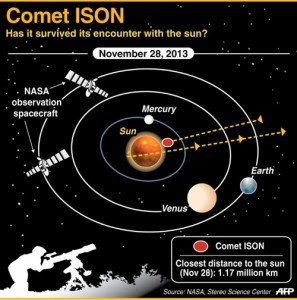
In this composition image obtained from National Aeronautics and Space Administration (NASA), Comet ISON (bottom) moves toward the sun in this image from ESA/NASA’s Solar and Heliospheric Observatory captured at 10:51 a.m. on Thursday (Friday in Manila). This image is a composite, with the sun imaged by NASA’s Solar Dynamics Observatory in the center, and SOHO showing the solar atmosphere, the corona. NASA spacecraft and scientists are watching the comet to see if it survives its perilous journey around the sun. AFP PHOTO
WASHINGTON, D.C.: Comet ISON appears to have flown too close to the surface of the sun on Thursday (Friday in Manila) and vanished as it circled the fiery surface, astronomers said.
Already have an active account? Log in here.
Continue reading with one of these options:
Continue reading with one of these options:
Premium + Digital Edition
Ad-free access
P 80 per month
(billed annually at P 960)
- Unlimited ad-free access to website articles
- Limited offer: Subscribe today and get digital edition access for free (accessible with up to 3 devices)
TRY FREE FOR 14 DAYS
See details
See details
If you have an active account, log in
here
.

